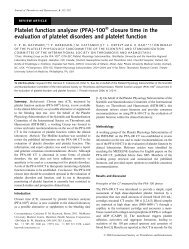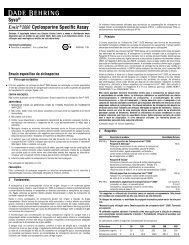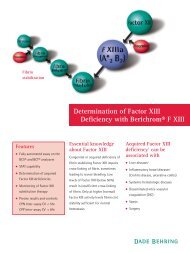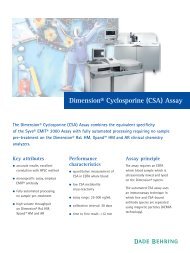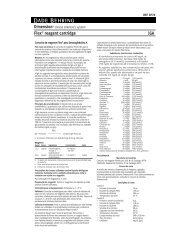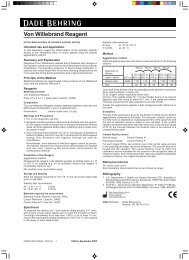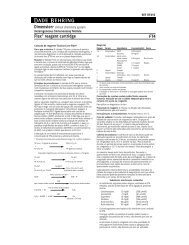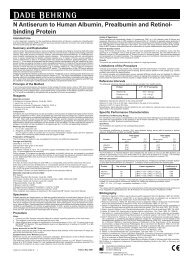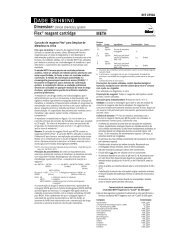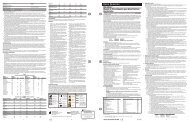Enzygnost* Anti-HBc monoclonal - Medcorp
Enzygnost* Anti-HBc monoclonal - Medcorp
Enzygnost* Anti-HBc monoclonal - Medcorp
Create successful ePaper yourself
Turn your PDF publications into a flip-book with our unique Google optimized e-Paper software.
Test procedure using the BEP ® IIIBefore using the BEP ® III, prepare the test plates and sample dispensing steps (Section 1 and 2at "Test procedure with the BEP ® II"). Immediately afterwards place the uncovered test plates(i.e. not covered with adhesive foil) into the BEP ® III. Note that partially filled test plates need tobe made up to at least half plates (6 test strips) by adding "water-filled strips". The test is thenprocessed fully automatically (see BEP ® III instruction manual).The settings for the incubation times in the BEP ® III software may differ from the times on theBEP ® II for technical reasons (system speed) but have been validated for <strong>Enzygnost*</strong> on theBEP ® III.Test procedure using the BEP ® 2000The sample dispensing steps and subsequent processing of the test are performed fully automaticallyby the analyzer (see BEP ® 2000 instruction manual).Test validationThe individual values of the absorbances for the control sera are used to calculate the meanvalues if:A neg. ≥ 0.700-0.010 ≤ A pos. ≤ 0.100If one of the absorbance values of the <strong>Anti</strong>-<strong>HBc</strong> Control Serum, negative, is outside thespecification, this value can be neglected.Both absorbance values of the positive control must comply with the specification. If theseconditions are not fulfilled, the test is to be repeated.EvaluationThe evaluations are performed automatically if the BEP ® 2000 or BEP ® III is used. Pleaseconsult the relevant instruction manuals. The following sections apply if the measurements arecarried out without using a software.Calculate the mean absorbance value of the negative controls and then calculate the cut-offvalue by multiplying the mean value by a factor of 0.4:–A neg. x 0.4 = cut-off valueThe equivocal range is defined as:cut-off ± 10%Based on the criteria of the test, the samples are classed as follows:Test result:1. A sample > cut-off + 10% ^= negative2. A sample < cut-off – 10% ^= positive3. cut-off - 10% ≤ A sample ≤ cut-off + 10% ^= equivocalIf an equivocal result is obtained the sample is to be retested in dual determination. If, in theretest, both absorbance values are above or below the equivocal range, the initial equivocalresult can be ignored and the sample can be classed as negative or positive, respectively.However, if the sample again reacts equivocally in one or both of the determinations of the retest,to obtain final clarification it is recommended that a new sample should be tested which has beencollected 2 to 4 weeks after the first sample.Limitations of the Procedure1. Samples containing sodium azide must not be used!2. <strong>Anti</strong>coagulants such as heparin, EDTA and citrate do not affect the test result.3. No interferences were observed with heat-treated samples (60 min, +56 °C).4. Serum from insufficiently coagulated blood, and cellular blood components, may lead tounreliable results.5. Samples that are haemolytic or contain rheumatoid factors do not impair the test results.6. Samples containing antibodies to CMV, and samples which are positive for anti-HBs, do notinterfere with the test result.OUWE G13 C0541 (879) CS/R 5



